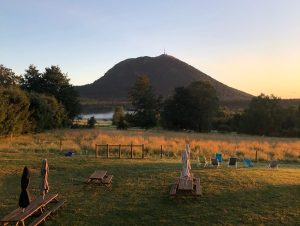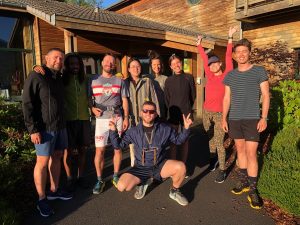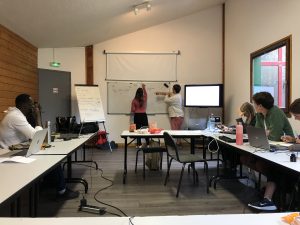
A hot sun was blazing down on us when we got off the Paris train in Clermont-Ferrand. Quite different from the cool, refreshing weather in Bergen, but a good first contact with summer. Most of the participants arrived around the same time, so there we were in the parking lot getting to know each other, while waiting for taxis to take us up the Auvergnese mountains in Laschamps. It was the first time I ever organized a summer school. Me and my ERASME colleagues (and indeed, friends) were experiencing a mix of joy, nervousness and excitement. We later found out it was the same for our participants.

The next morning half of the group hit the trails for a run before breakfast and the “official” kick-off. This habit continued throughout the whole week, through rain and sunny weather. We also managed to squeeze a night hike up Puy de la Vache and one up the emblematic Puy de Dome. Some chose to walk and have a bit of forest bathing. Those outdoor activities proved to be of great help during our intense working sessions. They allowed us to clear our heads, disconnect a bit from work and return to our tasks with a fresh mind. We started by building two system dynamics models together, going through all the initial steps: problem validation, dynamics hypothesis, variable choosing, causal loop diagrams, stock and flow diagrams and, finally, the model itself in STELLA, sensitivity analysis and model validation.

Then came the part where participants had to build a model from scratch, based on their research topics. It was enlightening and at the same time surprising to witness how differently people can conceptualize systems, draw causal relations and imagine system boundaries. Their models targeted topics ranging from biodiversity loss to integration of renewable energy sources, livestock dependency on imported feed, urban waste recycling, slum development or the supply chain of copper. During our four days of one-to-one interaction working closely on their own topics, we often had to change the roles: from teachers to students and back to teachers. We learned a lot from their topical insights, but also from the way they perceived systems and the questions they asked about the modelling process – some of which we never asked ourselves. During meals we had plenty of conversations about sustainability and different modelling approaches, but we equally got to know ourselves as humans and create close personal connections. Now that the summer school is over, I know for a fact that I will keep in touch with the participants and, at least with some of them, will work together in the near future.

On my desk, I have a reminder of these days in Laschamps. A drawing from Thibaud, the 8-year old son of ERASME’s scientific coordinator, Arnaud, also a dear friend of mine. He drew that as a birthday gift and I keep it close during working hours to remind me of all the amazing people and experiences that academia has offered me. Academia is not just science, theories and research methodologies.
It’s also the people behind all that work, the networks we create and the colleagues and friends we decide to keep close to us throughout the years. When we get lost – and that happens a lot in a field where you constantly need to question paradigms and mindsets – when we’re frustrated by lack of work progress, when we feel like we hit a dead end, that’s when need to remember what academia has to offer. And that’s when it’s a good time to call on one of the friends we made along the way.

Be First to Comment